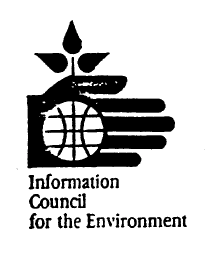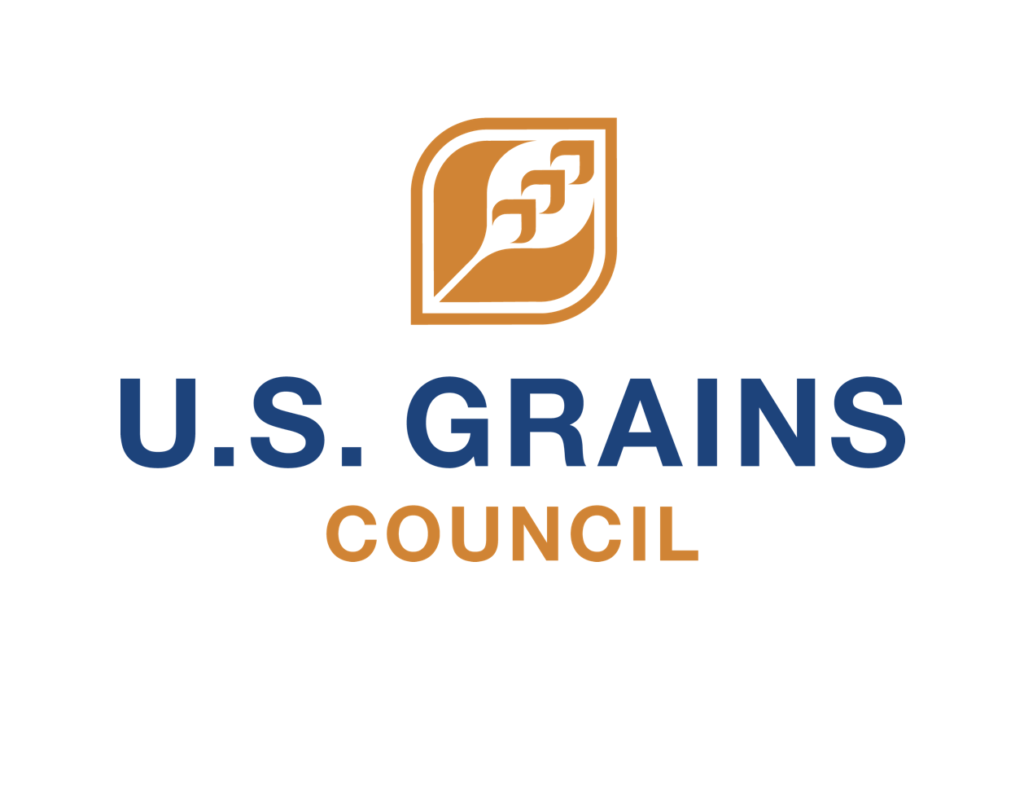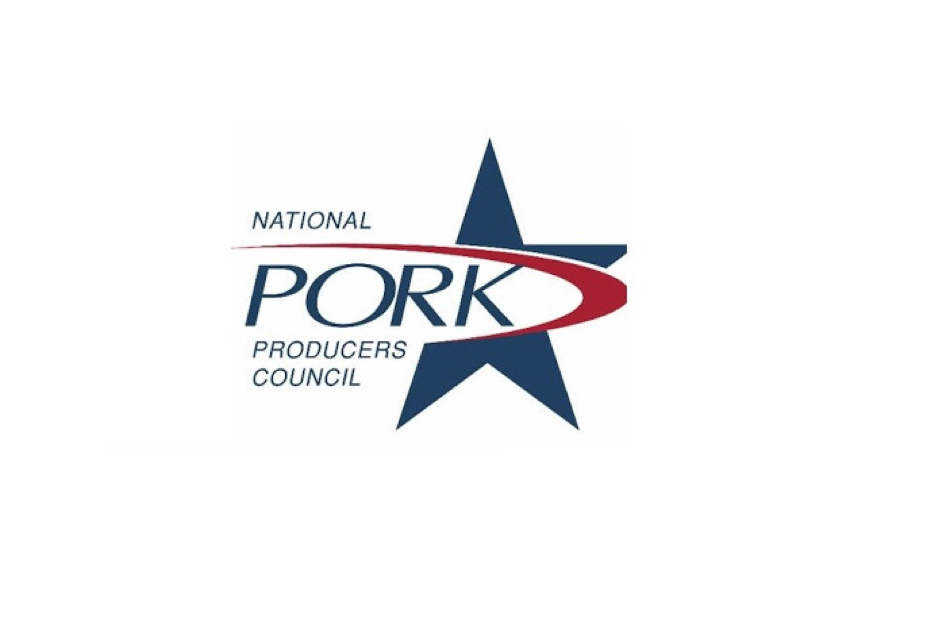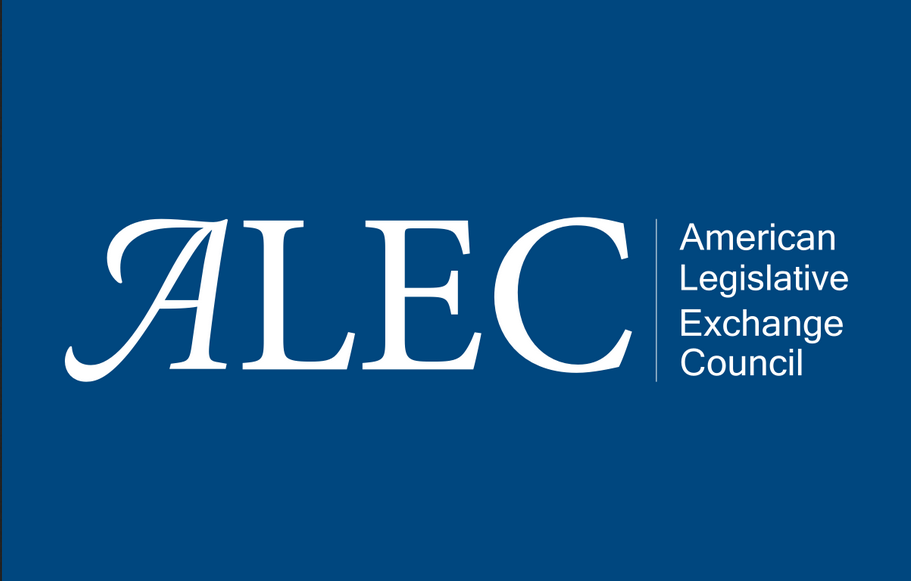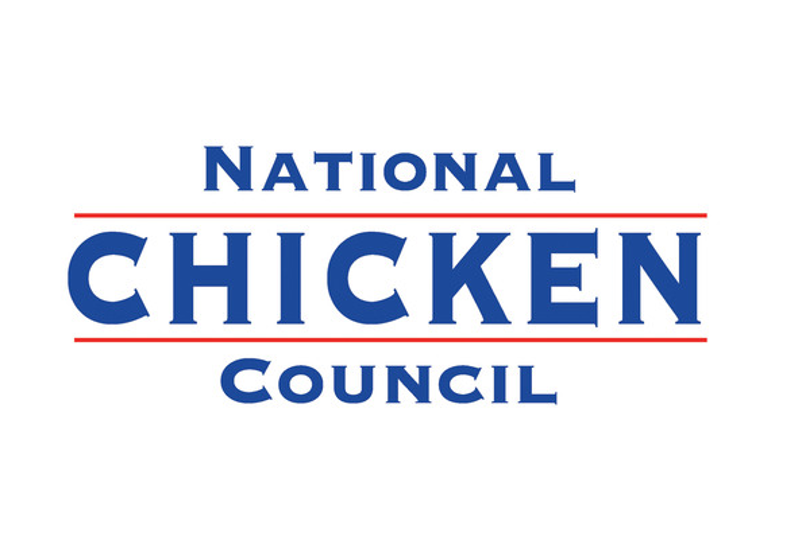Information Council for the Environment (ICE)
Background
The now-defunct Information Council for the Environment (ICE) was a program proposed by a coalition of U.S. coal companies including the Western Fuels Association and Southern Company, joined by the Edison Electric Institute.1“Distorting the Debate: A Case Study of Corporate Greenwashing,” Ozone Action, 1996. Retrieved from Greenpeace research documents.
The goal of the group was to “Reposition global warming as theory (not fact),” which it would accomplish through a series of radio and newspaper advertisements. The group would be guided by a “Science Advisory Panel” made up of scientists such as Robert Balling, Patrick Michaels, and Sherwood Idso, who would also contribute with public appearances and newspaper columns for the group, as outlined by the group’s communication plan and documented by Ozone Action.2“Distorting the Debate: A Case Study of Corporate Greenwashing,” Ozone Action, 1996. Retrieved from Greenpeace research documents.
One of the ads read “Who told you the earth was warming […] Chicken Little?” and claimed that “evidence that the earth is warming is weak.” It also claimed proof that carbon dioxide was the primary cause for climate change was “non existent.”3“Distorting the Debate: A Case Study of Corporate Greenwashing,” Ozone Action, 1996. Retrieved from Greenpeace research documents.
According to its communications plan, ICE’s Mission was as follows:4“Distorting the Debate: A Case Study of Corporate Greenwashing,” Ozone Action, 1996. Retrieved from Greenpeace research documents.
“The mission of the Informed Citizens for the Environment is to develop and effective national communications program to help ensure that action by the Administration and/or Congress on the issue is based on scientific evidence.”5“Distorting the Debate: A Case Study of Corporate Greenwashing,” Ozone Action, 1996. Retrieved from Greenpeace research documents.
ICE collapsed shortly after internal memoranda for their PR campaign were leaked to the press, after which Patrick Michaels distanced himself from the campaign, saying it contained “blatant dishonesty.6Ross Gelbspan. The Heat Is On: The Climate Crisis, The Cover-up, The Prescription. Dea Capo Press, September 22, 1998.
A 2015 report by the Union of Concerned Scientists (UCS) noted that ICE’s $500,000 advertising campaign “was designed to disparage climate science and cherry-pick the data to highlight claims of cooling temperatures in order to confuse the public.” UCS also noted that some remained disappointed that the ICE program could not have been continued. For example, Fred Palmer had written that , “it is unfortunate that ICE did not go forward” since the campaign did provoke a “dramatic turnaround in how people viewed the issue of global warming.”7“The Climate Deception Dossiers (2015),” Union of Concerned Scientists, July 9, 2015. Archived .pdf on file at DeSmog. Archive.is URL: https://archive.is/wC27p
ICE “Strategies”8“Distorting the Debate: A Case Study of Corporate Greenwashing,” Ozone Action, 1996. Retrieved from Greenpeace research documents.
- Reposition global warming as theory (not fact).
- Target print and radio media for maximum effectiveness.
- Achieve broad participation across the entire electric utility industry
- Start small, start well, and build on early successes.
- Get the test concepts developed and implemented as soon as possible.
- “Test Market” execution in early 1991.
- Build national involvement as soon as “test markets” results are in hand — summer 1991.
- Go national in the late fall of 1991 with a media program
- Use a spokesman from the scientific community.
Potential Program Names/Aliases
According to a report by Ozone Action, the initial plan for ICE proposed a number of potential program names:9“Distorting the Debate: A Case Study of Corporate Greenwashing,” Ozone Action, 1996. Retrieved from Greenpeace research documents.
- Informed Citizens for the Environment
- Information Council for the Environment
- Intelligent Concern for the Environment
- Informed Choices for the Environment
Gale Klappa & ICE
A report at the Energy & Policy Institute detailed the role of Gale Klappa in ICE, then vice president at Southern Company, and retired CEO of We Energies.10Matt Kasper. “Wisconsin Energy Corp. CEO, Gale Klappa, President of Global Warming Misinformation Campaign Earlier In His Career,” Energy and Policy Institute, July 8, 2015. 11“Gale E. Klappa,” WEC Energy Group. Archived April 1, 2017. Archive.is URL: https://archive.is/E3IPI 12“Chairman Gale Klappa stays atop We Energies’ parent-company pay,” Milwaukee Business Journal, March 24, 2017. Archive.is URL: https://archive.is/V215a
Back in 1991, Klappa was interviewed in a the New York Times article regarding the leaked ICE documents, saying:13Matt Kasper. “Wisconsin Energy Corp. CEO, Gale Klappa, President of Global Warming Misinformation Campaign Earlier In His Career,” Energy and Policy Institute, July 8, 2015. 14Matthew L. Wald. “Pro-Coal Ad Campaign Disputes Warming Idea,” The New York Times, July 8, 1991. Archived April 1, 2017. Archive.is URL: https://archive.is/otQY9
“Those who are predicting catastrophe have been very effective at getting their message across in national media, and in so-called ‘public service’ announcements. But there is another viewpoint, a substantial viewpoint from a body of reputable scientists, and that viewpoint has really not been made available to a large majority,” Klappa told The New York Times in a telephone interview.15Matt Kasper. “Wisconsin Energy Corp. CEO, Gale Klappa, President of Global Warming Misinformation Campaign Earlier In His Career,” Energy and Policy Institute, July 8, 2015.
Amy Jahns, Media Relations Specialist at We Energies, responded to Energy & Policy Institute writer Matt Kasper on how Klappa became involved in ICE. “Gale Klappa served as president of the ICE board more than 25 years ago,” she said, going on to present Wisconsin Energy’s emission control investments and reductions.16Matt Kasper. “Wisconsin Energy Corp. CEO, Gale Klappa, President of Global Warming Misinformation Campaign Earlier In His Career,” Energy and Policy Institute, July 8, 2015.
Stance on Climate Change
May 15, 1991
Writing on a templated letter with ICE letterhead, offering “additional information on global climate change,” Patrick Michaels wrote:17“Distorting the Debate: A Case Study of Corporate Greenwashing,” Ozone Action, 1996. Retrieved from Greenpeace research documents.
“We believe it is wrong to predict that higher levels of carbon dioxide will bring catastrophic global warming.”18“Distorting the Debate: A Case Study of Corporate Greenwashing,” Ozone Action, 1996. Retrieved from Greenpeace research documents.
Funding
ICE proposed the following plan for fundraising:19“Distorting the Debate: A Case Study of Corporate Greenwashing,” Ozone Action, 1996. Retrieved from Greenpeace research documents.
- Build support for the concept of the ICE strategy among our neighbors.
- Match Southern Company’s commitment by having four or five of our neighbors join us in raising $125,000 by January 31, 1991.
- Raise total commitments of $525,000 by January 31, 1991 to allow the test market project to proceed on schedule.20“Distorting the Debate: A Case Study of Corporate Greenwashing,” Ozone Action, 1996. Retrieved from Greenpeace research documents.
The initial proposed budget was $510,000 for Media, PR, Research, and Production in a number of test markets.21“Distorting the Debate: A Case Study of Corporate Greenwashing,” Ozone Action, 1996. Retrieved from Greenpeace research documents.
Research Documents via Greenpeace & Ozone Action
Key People
Science Advisory Panel (1991)22“Distorting the Debate: A Case Study of Corporate Greenwashing,” Ozone Action, 1996. Retrieved from Greenpeace research documents.
Board Members (1991)23“Distorting the Debate: A Case Study of Corporate Greenwashing,” Ozone Action, 1996. Retrieved from Greenpeace research documents.
- Gale Klappa — President.
- Fredrick D. Palmer — Vice President.
Actions
January 29, 2017
In an interview with DeSmog’s Graham Readfearn, Fred Palmer outlined the initial formation of ICE. He said that he had been approached by Gale Klappa, then of Southern Company, and Fred Lukens of Minnkota Power, asking him to join the board.24Graham Readfearn. “‘God Bless Trump’: 25 Years Ago This Man Kick Started the First Fossil Fuel–Funded Campaigns to Attack Climate Science,” DeSmog, January 29, 2017.
“I went to my board not long after the Hansen presentation, probably in 1990, and I said, you know, these coal plants have the most CO2 coming out of them than anywhere else. It was the top of the food chain, I called it. The board agreed. The board said I could go on the ICE board, so I did,” Palmer said.25Graham Readfearn. “‘God Bless Trump’: 25 Years Ago This Man Kick Started the First Fossil Fuel–Funded Campaigns to Attack Climate Science,” DeSmog, January 29, 2017.
However, he added that he soon became “dissatisfied” with ICE’s approach. Palmer said, “I didn’t think it was a PR issue. I thought it was a scientific educational issue.”26Graham Readfearn. “‘God Bless Trump’: 25 Years Ago This Man Kick Started the First Fossil Fuel–Funded Campaigns to Attack Climate Science,” DeSmog, January 29, 2017.
“I have always been about education, but I was chair (of ICE) and […] I looked at it and I said ‘I don’t like this’ and so we got out of ICE and it was abandoned and Western Fuels started the Greening Earth Society,” he added.27Graham Readfearn. “‘God Bless Trump’: 25 Years Ago This Man Kick Started the First Fossil Fuel–Funded Campaigns to Attack Climate Science,” DeSmog, January 29, 2017.
July 2015
A report by the Union of Concerned Scientists titled “The Climate Deception Dossiers“ included a section detailing the “misleading advertising” in the ICE campaign. The report noted that “ICE’s own internal documents show that as the organization was running its ad campaign the group was aware of science showing a ‘long-term warming trend,’ including record warmth and above-average temperatures.” 28“The Climate Deception Dossiers (2015),” Union of Concerned Scientists, July 9, 2015. Archived .pdf on file at DeSmog. Archive.is URL: https://archive.is/wC27p
May 2, 1991
According to correspondence to Bill Brier of the Edison Electric Institute, ICE’s “test market materials” included five newspaper adverts and four sixty-second radio spots. The newspaper ads would run week beginning May 12, and end June 9.29“Distorting the Debate: A Case Study of Corporate Greenwashing,” Ozone Action, 1996. Retrieved from Greenpeace research documents.
The radio ads would run in Flagstaff, featuring Dr. Bob Balling, with the final two weeks featuring ads with both Balling and Bruce Williams. Ads in the Bowling Green region would also feature Pat Michaels.30“Distorting the Debate: A Case Study of Corporate Greenwashing,” Ozone Action, 1996. Retrieved from Greenpeace research documents.
The following text was proposed for an ad on the Rush Limbaugh show, which would run in Fargo and Bowling Green according to the letter to Bill Brier:31“Distorting the Debate: A Case Study of Corporate Greenwashing,” Ozone Action, 1996. Retrieved from Greenpeace research documents.
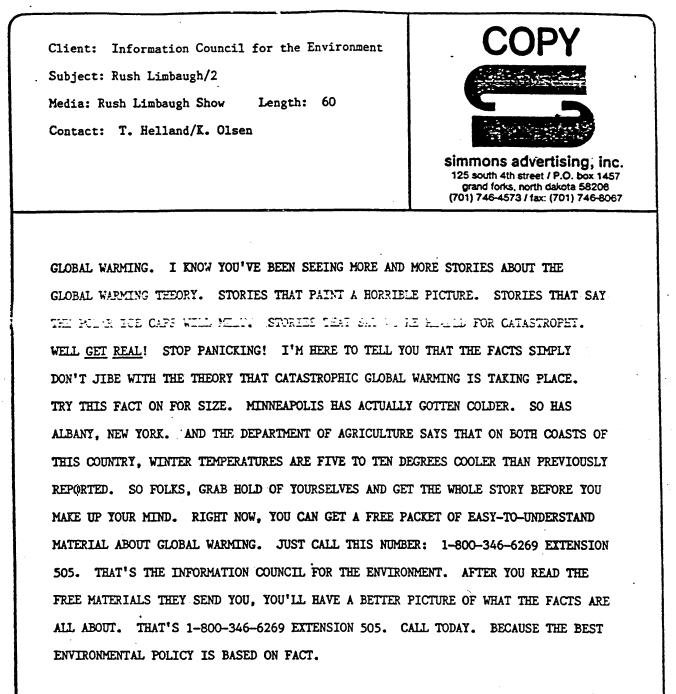
The letter is signed by Fred Lukens, and CC’d to Gale Klappa.
February 13–22, 1991
ICE commissioned a telephone survey consisting of 1500 interviews with objectives to identify the following:32“Distorting the Debate: A Case Study of Corporate Greenwashing,” Ozone Action, 1996. Retrieved from Greenpeace research documents.
- Current awareness and familiarity with the global warming issue;
- Recent exposure to information concerning global warming, including the types of media and sources in which the information appeared;
- Responses to various messages concerning global warming;
- Assessments of the credibility of various spokespersons and groups on topics related to global warming;
- Key audiences and media for messages concerning global warming.
The survey report includes a number of recommendations for ICE. With regard to target audiences, it suggests that “older, less-educated males who are not typically active information-seekers” are more likely to ‘favor the ICE agenda’.”33“Distorting the Debate: A Case Study of Corporate Greenwashing,” Ozone Action, 1996. Retrieved from Greenpeace research documents.
“One possible target audience includes those who are most receptive to messages describing the motivations and vested interests of people currently making pronouncements on global warming—for example, the statement that some members of the media scare the public about global warming to increase their audience and their influence. People who respond most favorably to such statements are older, less-educated males from larger households, who are not typically active information-seekers, and are not likely to be ‘green’ consumers,” the report reads.
“Members of this group are skeptical about global warming, predisposed to favor the ICE agenda, and likely to be even more supportive of that agenda following exposure to new information. They are not, however, accustomed to taking political action. They are good targets for radio advertisements.
“Another possible target segment is younger, lower-income women. These women are more receptive than other audience segments to factual information concerning the evidence for global warming. They are likely to be “green” consumers, to believe the earth is warming, and to think the problem is serious. However, they are also likely to soften their support for federal legislation after hearing new information on global warming. These women are good targets for magazine advertisements.”34“Distorting the Debate: A Case Study of Corporate Greenwashing,” Ozone Action, 1996. Retrieved from Greenpeace research documents.
Public Relations Tour
May 20, 1991
As part of an ICE “public relations tour,” the group proposed the following schedule:35“Distorting the Debate: A Case Study of Corporate Greenwashing,” Ozone Action, 1996. Retrieved from Greenpeace research documents.
11:00 a.m.
Meet with editors and writers at the Arizona Daily Sun. Dr. Robert
Balling from Arizona State University or Dr. Sherwood Idso from the U.S. Water Conservation Laboratory will replace Dr. Michaels for the Flagstaff meetings.1:00 p.m.
Tape appearance on North Arizona Outlook, weekly public affairs program on KN.AZ-TV.3:00 p.m.
Appearance on KNAU-AM radio talk show.
May 15, 1991
12:30 p.m.
Meet with editors and writers at The Fargo Forum.2:00 p.m.
Tape appearance on KX4 News Conference on KXJB-TV. Program is hosted by Kathy Coyle and airs on Sundays.4:00 p.m.
Appear on KTHI-TV’s On The Line hosted by Steve Poitras. Half-hour program.5:00 p.m.
Meeting with editorial staff at WDAY-TV. Tape interview for evening news.
May 14, 1991
10:45 a.m.
Appearance on WBKO-TV’s “Midday” hosted by Beverly Kirk.1:00 p.m.
Meet with editors and writers at the Bowling Green Daily News.2:30 PM
Tape appearance on WKYU-TV’s “Outlook” hosted by Barbara Deeb. Tape will also be broadcast on WKYU-FM’s “Midday Edition”
Sample ICE Ads
*Click to view full-size images.36“Distorting the Debate: A Case Study of Corporate Greenwashing,” Ozone Action, 1996. Retrieved from Greenpeace research documents.
“The most serious problem with catastrophic global warming is–it may not be true.”
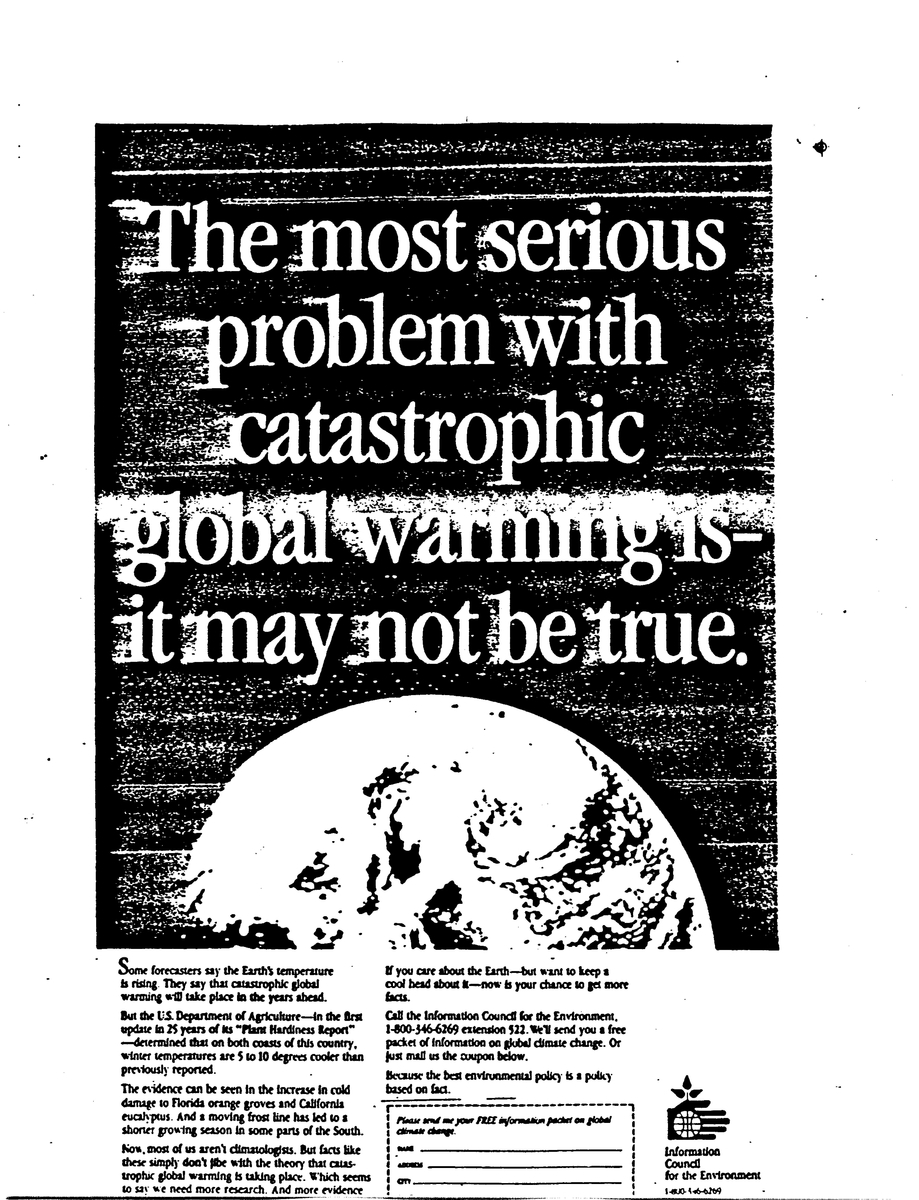
“Who told you the earth was warming… Chicken Little?”
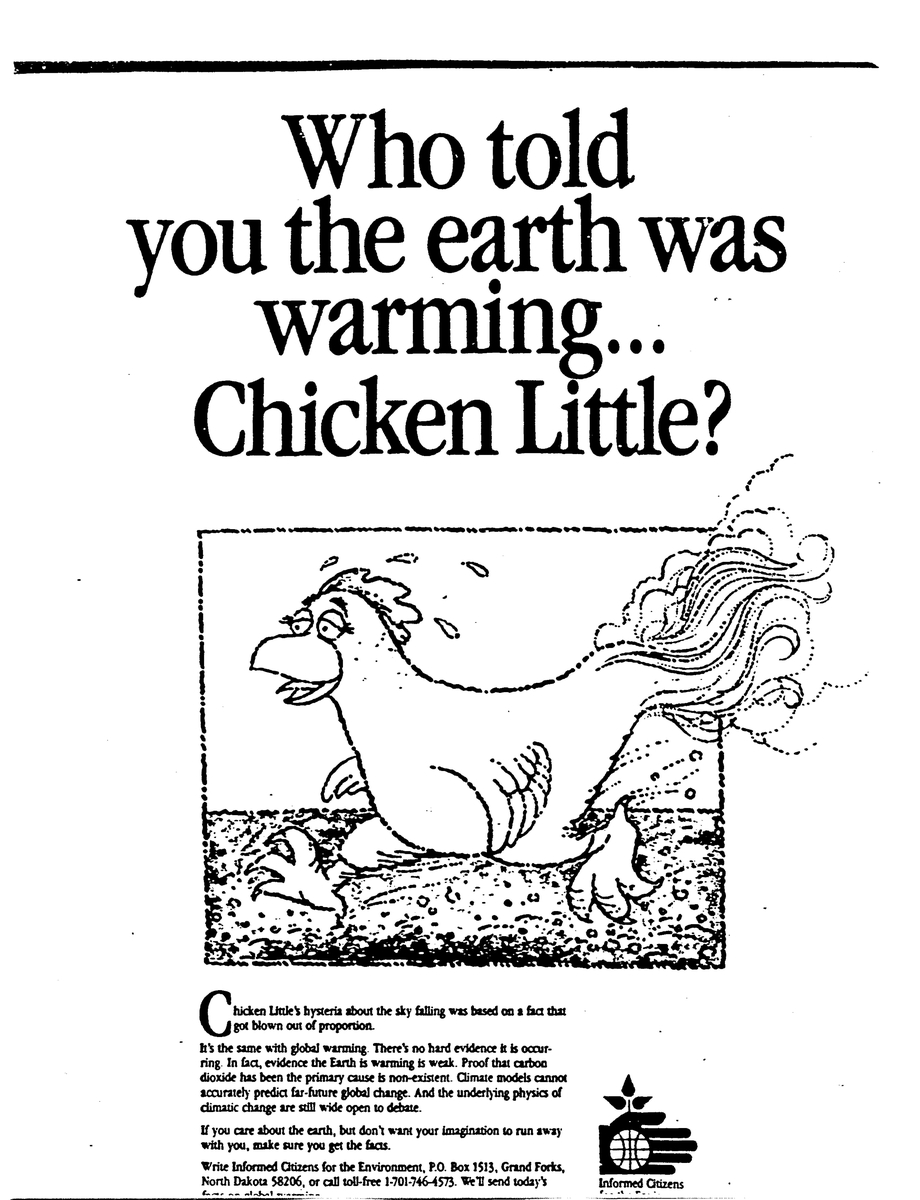
“Doomsday is Cancelled. Again.”
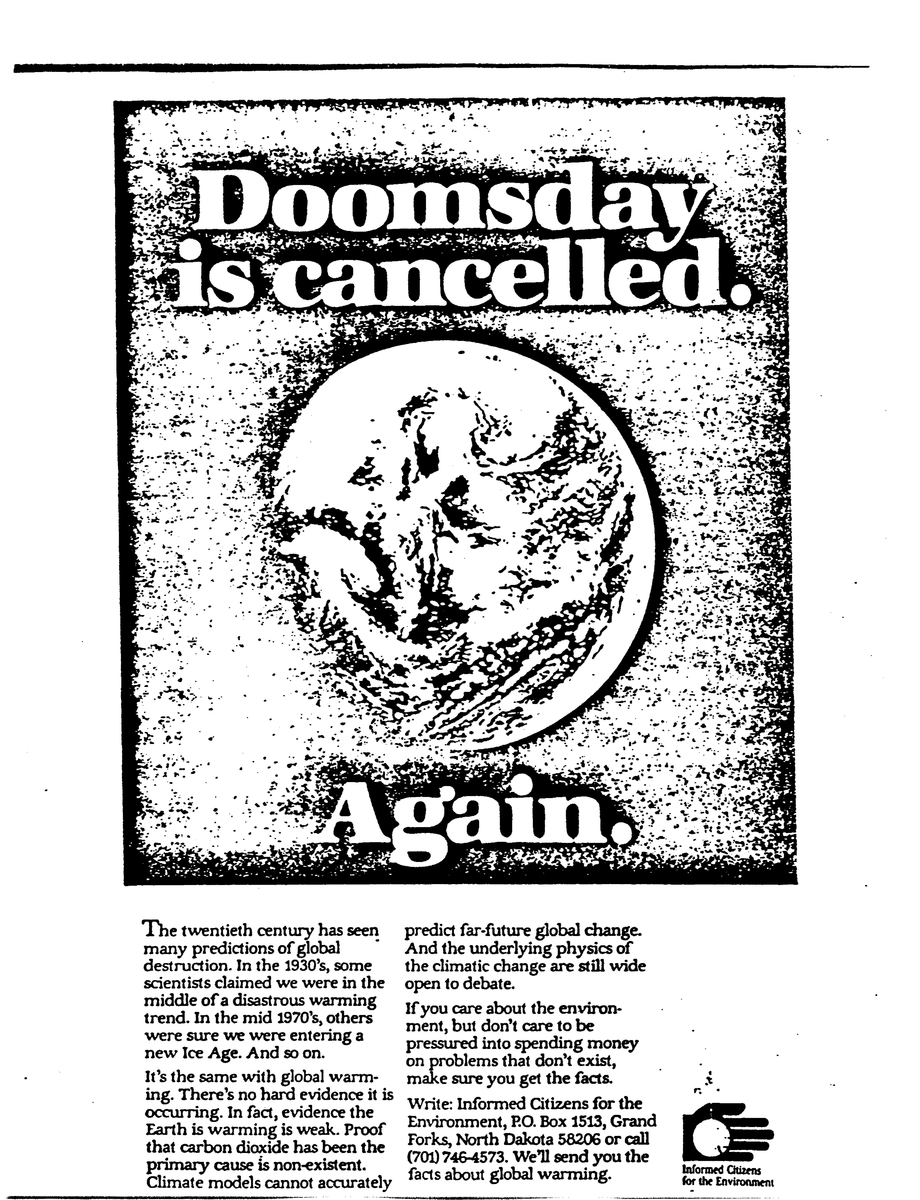
Related Organizations
- Western Fuels Association (WFA)37“Distorting the Debate: A Case Study of Corporate Greenwashing,” Ozone Action, 1996. Retrieved from Greenpeace research documents.
Contact & Address
The following address was present on ICE letterhead:38“Distorting the Debate: A Case Study of Corporate Greenwashing,” Ozone Action, 1996. Retrieved from Greenpeace research documents.
P.O. Box 414998
Kansas City MO 64141-4998
1-800-346-6269
Other Resources
- “Information Council on the Environment,” Wikipedia.
- “The Coal Industry’s ‘ICE’ Campaign (1999),” The Heat is Online.
Resources
- 1“Distorting the Debate: A Case Study of Corporate Greenwashing,” Ozone Action, 1996. Retrieved from Greenpeace research documents.
- 2“Distorting the Debate: A Case Study of Corporate Greenwashing,” Ozone Action, 1996. Retrieved from Greenpeace research documents.
- 3“Distorting the Debate: A Case Study of Corporate Greenwashing,” Ozone Action, 1996. Retrieved from Greenpeace research documents.
- 4“Distorting the Debate: A Case Study of Corporate Greenwashing,” Ozone Action, 1996. Retrieved from Greenpeace research documents.
- 5“Distorting the Debate: A Case Study of Corporate Greenwashing,” Ozone Action, 1996. Retrieved from Greenpeace research documents.
- 6Ross Gelbspan. The Heat Is On: The Climate Crisis, The Cover-up, The Prescription. Dea Capo Press, September 22, 1998.
- 7“The Climate Deception Dossiers (2015),” Union of Concerned Scientists, July 9, 2015. Archived .pdf on file at DeSmog. Archive.is URL: https://archive.is/wC27p
- 8“Distorting the Debate: A Case Study of Corporate Greenwashing,” Ozone Action, 1996. Retrieved from Greenpeace research documents.
- 9“Distorting the Debate: A Case Study of Corporate Greenwashing,” Ozone Action, 1996. Retrieved from Greenpeace research documents.
- 10Matt Kasper. “Wisconsin Energy Corp. CEO, Gale Klappa, President of Global Warming Misinformation Campaign Earlier In His Career,” Energy and Policy Institute, July 8, 2015.
- 11“Gale E. Klappa,” WEC Energy Group. Archived April 1, 2017. Archive.is URL: https://archive.is/E3IPI
- 12“Chairman Gale Klappa stays atop We Energies’ parent-company pay,” Milwaukee Business Journal, March 24, 2017. Archive.is URL: https://archive.is/V215a
- 13Matt Kasper. “Wisconsin Energy Corp. CEO, Gale Klappa, President of Global Warming Misinformation Campaign Earlier In His Career,” Energy and Policy Institute, July 8, 2015.
- 14Matthew L. Wald. “Pro-Coal Ad Campaign Disputes Warming Idea,” The New York Times, July 8, 1991. Archived April 1, 2017. Archive.is URL: https://archive.is/otQY9
- 15Matt Kasper. “Wisconsin Energy Corp. CEO, Gale Klappa, President of Global Warming Misinformation Campaign Earlier In His Career,” Energy and Policy Institute, July 8, 2015.
- 16Matt Kasper. “Wisconsin Energy Corp. CEO, Gale Klappa, President of Global Warming Misinformation Campaign Earlier In His Career,” Energy and Policy Institute, July 8, 2015.
- 17“Distorting the Debate: A Case Study of Corporate Greenwashing,” Ozone Action, 1996. Retrieved from Greenpeace research documents.
- 18“Distorting the Debate: A Case Study of Corporate Greenwashing,” Ozone Action, 1996. Retrieved from Greenpeace research documents.
- 19“Distorting the Debate: A Case Study of Corporate Greenwashing,” Ozone Action, 1996. Retrieved from Greenpeace research documents.
- 20“Distorting the Debate: A Case Study of Corporate Greenwashing,” Ozone Action, 1996. Retrieved from Greenpeace research documents.
- 21“Distorting the Debate: A Case Study of Corporate Greenwashing,” Ozone Action, 1996. Retrieved from Greenpeace research documents.
- 22“Distorting the Debate: A Case Study of Corporate Greenwashing,” Ozone Action, 1996. Retrieved from Greenpeace research documents.
- 23“Distorting the Debate: A Case Study of Corporate Greenwashing,” Ozone Action, 1996. Retrieved from Greenpeace research documents.
- 24Graham Readfearn. “‘God Bless Trump’: 25 Years Ago This Man Kick Started the First Fossil Fuel–Funded Campaigns to Attack Climate Science,” DeSmog, January 29, 2017.
- 25Graham Readfearn. “‘God Bless Trump’: 25 Years Ago This Man Kick Started the First Fossil Fuel–Funded Campaigns to Attack Climate Science,” DeSmog, January 29, 2017.
- 26Graham Readfearn. “‘God Bless Trump’: 25 Years Ago This Man Kick Started the First Fossil Fuel–Funded Campaigns to Attack Climate Science,” DeSmog, January 29, 2017.
- 27Graham Readfearn. “‘God Bless Trump’: 25 Years Ago This Man Kick Started the First Fossil Fuel–Funded Campaigns to Attack Climate Science,” DeSmog, January 29, 2017.
- 28“The Climate Deception Dossiers (2015),” Union of Concerned Scientists, July 9, 2015. Archived .pdf on file at DeSmog. Archive.is URL: https://archive.is/wC27p
- 29“Distorting the Debate: A Case Study of Corporate Greenwashing,” Ozone Action, 1996. Retrieved from Greenpeace research documents.
- 30“Distorting the Debate: A Case Study of Corporate Greenwashing,” Ozone Action, 1996. Retrieved from Greenpeace research documents.
- 31“Distorting the Debate: A Case Study of Corporate Greenwashing,” Ozone Action, 1996. Retrieved from Greenpeace research documents.
- 32“Distorting the Debate: A Case Study of Corporate Greenwashing,” Ozone Action, 1996. Retrieved from Greenpeace research documents.
- 33“Distorting the Debate: A Case Study of Corporate Greenwashing,” Ozone Action, 1996. Retrieved from Greenpeace research documents.
- 34“Distorting the Debate: A Case Study of Corporate Greenwashing,” Ozone Action, 1996. Retrieved from Greenpeace research documents.
- 35“Distorting the Debate: A Case Study of Corporate Greenwashing,” Ozone Action, 1996. Retrieved from Greenpeace research documents.
- 36“Distorting the Debate: A Case Study of Corporate Greenwashing,” Ozone Action, 1996. Retrieved from Greenpeace research documents.
- 37“Distorting the Debate: A Case Study of Corporate Greenwashing,” Ozone Action, 1996. Retrieved from Greenpeace research documents.
- 38“Distorting the Debate: A Case Study of Corporate Greenwashing,” Ozone Action, 1996. Retrieved from Greenpeace research documents.

